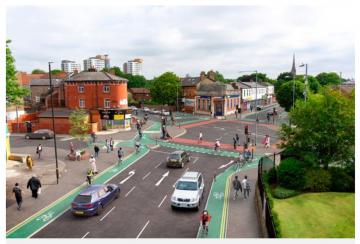
At the Cycling UK and Cyclenation campaigners' conference on Sat 24th Nov in Birmingham, we will be hearing more about Manchester's Beelines and how they are being designed with local residents, as well as learning about the principles behind Low Traffic Neighbourhoods, through the example of the mini-Holland in Waltham Forest. Tickets only £10 (concessions available, and children under 18 are free).
This image is the one that most people will have in their heads when you mention 'Manchester's Beelines', but is this what most of the new cycle network will look like? Not in the immediate future. Instead many of the routes will look like ordinary streets, with money focused on improving the points where the routes cross barriers such as main roads, the metro network and the canals. There will be main road schemes, as in the picture above, but there will also be 1,400 safer road crossings to link up quiet streets carrying much of the cycle network. As in the Netherlands, much of the cycle network won't be on infrastructure that appears designed for cycling, but instead will be on roads that appear to be designed for local residents.
But the experience of quiet ways in London and in Birmingham is that side roads with rat-running motor traffic are not really quiet ways, and so they fail to encourage more cycling and walking. If we want quiet ways to work, then they need to be genuinely quiet, with no rat-running traffic, which means that they need to be filtered routes with perhaps no more than 100 to 200 motor vehicles trips along them per day. So to make a success of their quiet way Beelines, Manchester will need to filter out the rat-running motor traffic, to make the routes truly attractive for walking and cycling. But we need to be careful how we do this - where Transport for London (TfL) consulted on filtered permeability only on the streets where a quiet route was going in, and not on the surrounding streets, the local residents objected. They saw the measures as there only to benefit the people cycling, and were upset that they would be inconvenienced to help this lycra-clad boy racers who would mow down their children when they were crossing the road.
Transport for London has changed their tactics, and is now mainly encouraging area-wide measures to achieve gains in walking and cycling, selling the measures as positive for local residents. These changes are packaged up as 'Healthy Streets', and TfL have developed a package of measures and tools that designers can use to implement these, and has just launched a data hub with evidence of the benefits of the approach. But in among all the very pleasant and attractive changes that can be made to streets to make them more healthy, it is important that we do not lose sight of the most important point of all: Eliminating through motor traffic, or 'rat-runs'. This is important to emphasis, because it is easy to focus on the rest of the features of Healthy Streets and skim over that point, as the draft "Healthy and Active Street" document from the West Midlands Combined Authority did in January 2018. The closest mention of cutting rat-runs is this single sentence: "A reallocation of road space for more active forms of transport or closing roads off to some traffic can help to locate infrastructure [for active travel] in the right place." Cutting through motor traffic here needs to be justified as providing space for installing active travel infrastructure, not as an end in itself for the local residents. (To be fair to WMCA, I have not been able to find the final draft of that document, and it may have improved substantially, but WMCA's recent Congestion Management Action Plan does not mention any measures to restrict rat-running traffic either.)
Manchester does not look like it will fall into the trap that the West Midlands has and ignore rat-running cars. The plans for the Beelines includes 25 'filtered neighbourhoods', defined as streets with "cul-de-sac like access for cars", in other words, with rat-running cars blocked but people walking and cycling allowed through. And this is the core of the concept of Low Traffic Neighbourhoods, produced by Living Streets and the London Cycling Campaign, focusing on the central principle of what has allowed parts of London like Hackney and Waltham Forest to create pleasant streets for living on that encourage walking and cycling. These measures do not even need to be very expensive; a road closure can cost as little as £6,000, so Andy Street could create 1,000 filtered streets across the West Midlands with his latest funding announcement. With the money that TfGM has promised for the Beelines, they will be able to deliver filtered streets with a more attractive style. If they remain focused on delivering properly filtered neighbourhoods for local residents, then they will also succeed in delivering their Beelines network for cycling; their success will truly rely on the concept of Low Traffic Neighbourhoods.


